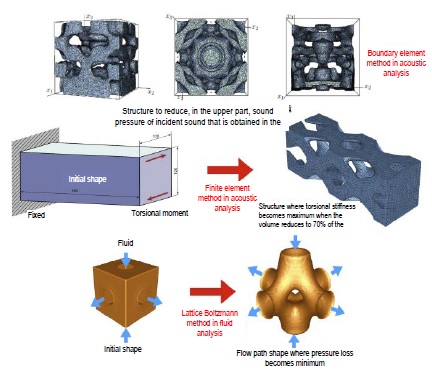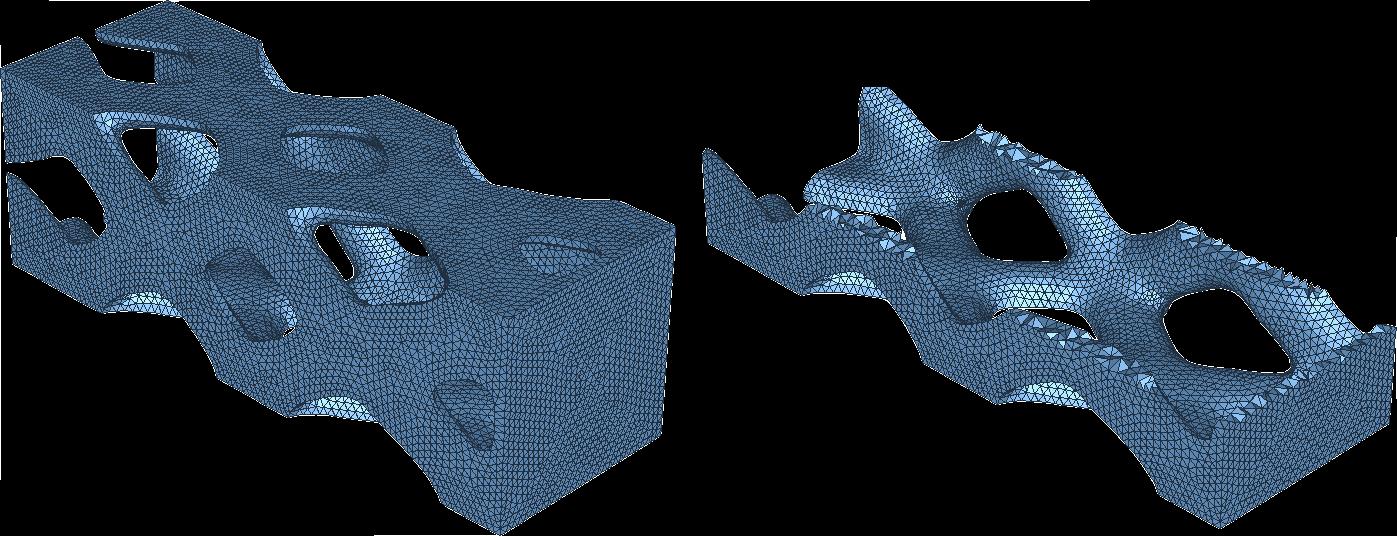Nagoya University, Mechanical Systems Engineering, Matsumoto Laboratory
 Optimization technology of shape and topology of a mechanical structure
Optimization technology of shape and topology of a mechanical structure
- Technical Classification:
- [ Product Design ]
- Products:
- Keyword:
- [ automobile members ] [ Optimization of topology ] [ optimum structural design ] [ structural members ]
Point of the Proposed Technology
We have developed advanced structure optimization techniques, in which the finite element method (FEM), the boundary element method (BEM) and the lattice Boltzmann method are combined with the level set method, such as: technology for optimizing a shape of structure so that the structural volume is reduced and the rigidity is maximized; technology for optimizing a shape of sound field so that noise is reduced and optimum acoustic characteristics of the inside of a vehicle or hall are provided; technology for determining a shape of structure in reverse so that an optimum natural frequency value is obtained; technology for optimizing a shape of a dielectric or scatterer controlling the electric field or magnetic field strength; technology for optimizing a shape or arrangement of cooling pipes targeting a 3D printer used for controlling the temperature of mold cavity in higher accuracy; and technology for optimizing a shape or topology of a flow channel that enables minimization or maximization of pressure loss. In the process of calculation, structure is divided again into meshes, so that calculation is made in high accuracy, and the STL data for a 3D printer is directly output from an obtained shape. It is also possible to execute optimization of topology in high accuracy where natural frequency, which has low accuracy in conventional methods, is optimized.
Effect(s)
Conventional Technology
Structural optimization for maximizing the performance of a machine material or structure by changing the shape of the machine material or structure has been studied for a long time.
Structural optimization techniques are broadly classified into (a) dimensional optimization, (b) shape optimization, and (c) topology optimization. Among them, in the topology optimization, a proposed design can be calculated even with the topology (the number of holes) being set as unknown. Therefore, it has gained much attention as a very flexible structural optimization method. In the conventional technology, however, the initially conceived design area is filled with a material, and the distribution of the material is represented with light and shade for its absence and presence, and therefore, even for an area where actually, no material exists, a calculation was required with a material constant being given. As a result, there were problems that it is impossible to solve such problems that force is applied on the surface of the material distribution, that the natural frequency value is different from the actual optimum structural shape in optimization of a vibrational state, or the like.

Structural optimization techniques are broadly classified into (a) dimensional optimization, (b) shape optimization, and (c) topology optimization. Among them, in the topology optimization, a proposed design can be calculated even with the topology (the number of holes) being set as unknown. Therefore, it has gained much attention as a very flexible structural optimization method. In the conventional technology, however, the initially conceived design area is filled with a material, and the distribution of the material is represented with light and shade for its absence and presence, and therefore, even for an area where actually, no material exists, a calculation was required with a material constant being given. As a result, there were problems that it is impossible to solve such problems that force is applied on the surface of the material distribution, that the natural frequency value is different from the actual optimum structural shape in optimization of a vibrational state, or the like.

New Technology
In the same way as the conventional technique, this technique is also related to a technique of calculating the shape of structure so that the given conditions such as rigidity and natural frequency are satisfied for the structure consisting of various materials including carbon fiber composites. In other words, by making good use of the simulation technologies using computers such as FEM and BEM, optimization of the shape of a structure or space is conducted. In this process, first, a provisional shape of a structure is made, and then calculation is repeated, while modifications of the shape in such a manner that produces a given effect are made. The conventional method is based on such an idea that even if the initial design area is actually filled with the material, its density becomes smaller. This technology is new on the point that using the level set function, the area where actually the structure exists is identified in the calculation process, and its surface or area is divided into meshes required for simulation by FEM or BEM. We have also developed a technology for increasing the calculation speed by avoiding waste in the calculation in order to repeat simulations. Use of this technology enables a high accuracy optimization of shape and topology of structure including occurrence or non-occurrence of a hole or cavity in various fields described below. In addition, the obtained shape has been already divided into meshes, and so it can be automatically stored as STL data, facilitating trial production of the actual structure by a 3D printer.


Technology Deployment and Cooperation
- Joint Researchers (their role)
- Example of Application
- Optimum design of automobile chassis members, maximization of the stiffness of a structure, optimization of the shape for optimum arrangement of natural frequency, optimum design of the sound field shape or an acoustic device, optimum design of an electromagnetic antenna, optimum shape and arrangement of cooling pipes in injection molds, optimization of the flow cavities
- Technical Problems
- Collaborator needed to Improve
- Technical WEB page
- http://www.matsumoto.nuem.nagoya-u.ac.jp
Inquiries
- Personnel / Department
- Department of Mechanical Science and Engineering / Professor, Toshiro Matsumoto / Assistant professor, Hiroshi Isakari
- Address
- Furo-cho, Chikusa-ku, Nagoya-shi, Aichi, 464-8603 Japan
- Contact
-
TEL:+81-52-789-2780 (Matsumoto), +81-52-789-2781 (Isakari)
FAX:+81-52-789-3123
Inquiry Form
Outline of Company and Organization
- Location
- Furo-cho, Chikusa-ku, Nagoya-shi, Aichi, 464-8603 Japan
- Contact
-
TEL:+81-52-789-2780
FAX:+81-52-789-3123
- Capital / No. of Employees
- 0 yen /
- Product Line
- Major Customers
- Overseas Base(s)
- Certification
- Company/Organization WEB page
- http://www.mae.nagoya-u.ac.jp/ja/graduate/mech
Update date: 2020/2/16